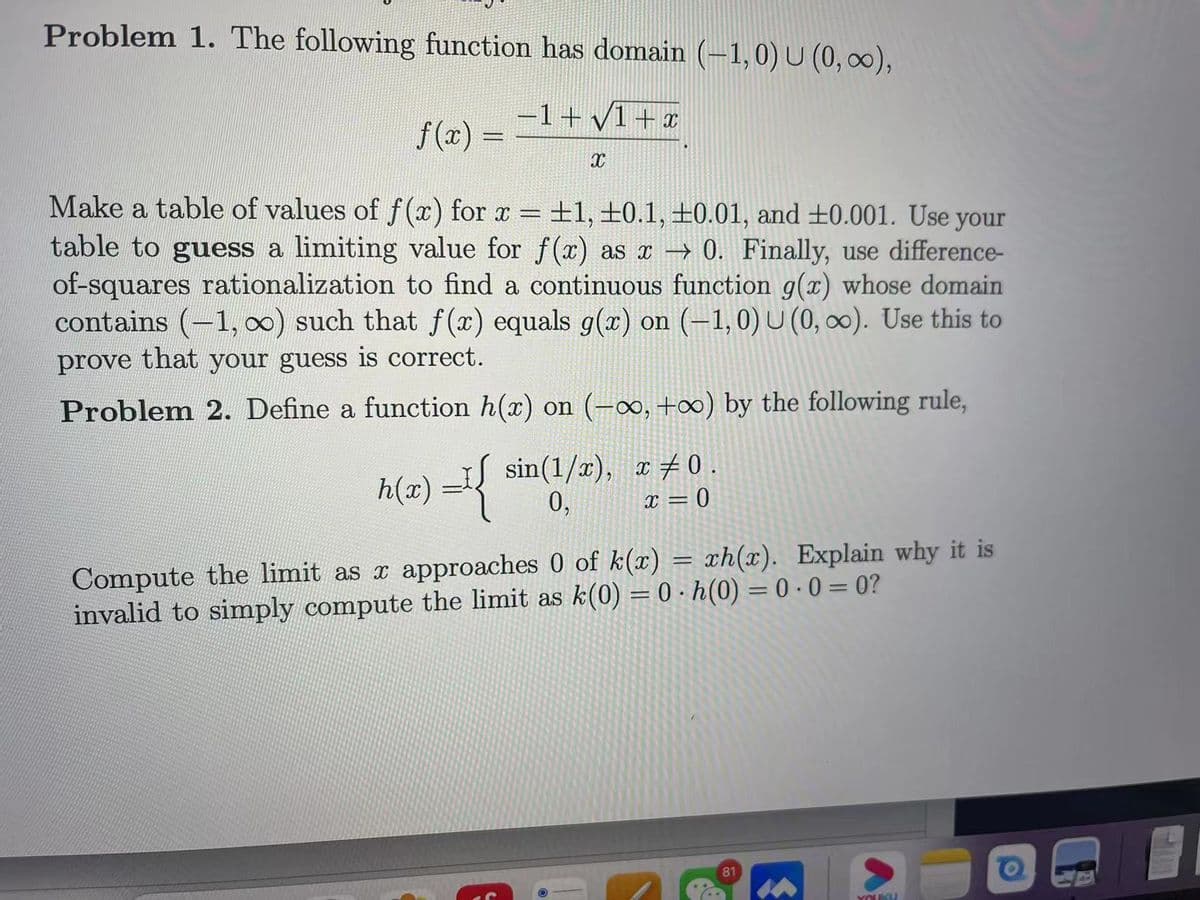Problem 1. The following function has domain (-1,0) U (0, ∞), −1+√1+x X f(x) = Make a table of values of f(x) for x = ±1, 0.1, 0.01, and ±0.001. Use your table to guess a limiting value for f(x) as x→0. Finally, use difference- of-squares rationalization to find a continuous function g(x) whose domain contains (-1, ∞) such that f(x) equals g(x) on (-1,0) U (0, ∞). Use this to prove that your guess is correct.
Problem 1. The following function has domain (-1,0) U (0, ∞), −1+√1+x X f(x) = Make a table of values of f(x) for x = ±1, 0.1, 0.01, and ±0.001. Use your table to guess a limiting value for f(x) as x→0. Finally, use difference- of-squares rationalization to find a continuous function g(x) whose domain contains (-1, ∞) such that f(x) equals g(x) on (-1,0) U (0, ∞). Use this to prove that your guess is correct.
Advanced Engineering Mathematics
10th Edition
ISBN:9780470458365
Author:Erwin Kreyszig
Publisher:Erwin Kreyszig
Chapter2: Second-order Linear Odes
Section: Chapter Questions
Problem 1RQ
Related questions
Question
Problem 1. The following function has domain (−1, 0) ∪ (0, ∞), f(x)=(-1+√1+x)/x
Make a table of values of f (x) for x = ±1, ±0.1, ±0.01, and ±0.001. Use your table to guess a limiting value for f(x) as x → 0. Finally, use difference- of-squares rationalization to find a continuous function g(x) whose domain contains (−1, ∞) such that f (x) equals g(x) on (−1, 0) ∪ (0, ∞). Use this to prove that your guess is correct.

Transcribed Image Text:Problem 1. The following function has domain (-1,0) U (0, ∞0),
−1+√1+x
Xx
f(x) =
Make a table of values of f(x) for x = ±1, 0.1, 0.01, and ±0.001. Use your
table to guess a limiting value for f(x) as x → 0. Finally, use difference-
of-squares rationalization to find a continuous function g(x) whose domain
contains (-1, ∞) such that f(x) equals g(x) on (-1,0) U (0, ∞o). Use this to
prove that your guess is correct.
Problem 2. Define a function h(x) on (-∞, +∞) by the following rule,
sin (1/x), x 0.
x=0
h(x) =X{ 0,
Compute the limit as x approaches 0 of k(x) = xh(x). Explain why it is
invalid to simply compute the limit as k(0) = 0.h(0)=0.0=0?
81
YOUKY
Expert Solution
This question has been solved!
Explore an expertly crafted, step-by-step solution for a thorough understanding of key concepts.
This is a popular solution!
Trending now
This is a popular solution!
Step by step
Solved in 2 steps

Recommended textbooks for you

Advanced Engineering Mathematics
Advanced Math
ISBN:
9780470458365
Author:
Erwin Kreyszig
Publisher:
Wiley, John & Sons, Incorporated

Numerical Methods for Engineers
Advanced Math
ISBN:
9780073397924
Author:
Steven C. Chapra Dr., Raymond P. Canale
Publisher:
McGraw-Hill Education

Introductory Mathematics for Engineering Applicat…
Advanced Math
ISBN:
9781118141809
Author:
Nathan Klingbeil
Publisher:
WILEY

Advanced Engineering Mathematics
Advanced Math
ISBN:
9780470458365
Author:
Erwin Kreyszig
Publisher:
Wiley, John & Sons, Incorporated

Numerical Methods for Engineers
Advanced Math
ISBN:
9780073397924
Author:
Steven C. Chapra Dr., Raymond P. Canale
Publisher:
McGraw-Hill Education

Introductory Mathematics for Engineering Applicat…
Advanced Math
ISBN:
9781118141809
Author:
Nathan Klingbeil
Publisher:
WILEY

Mathematics For Machine Technology
Advanced Math
ISBN:
9781337798310
Author:
Peterson, John.
Publisher:
Cengage Learning,

